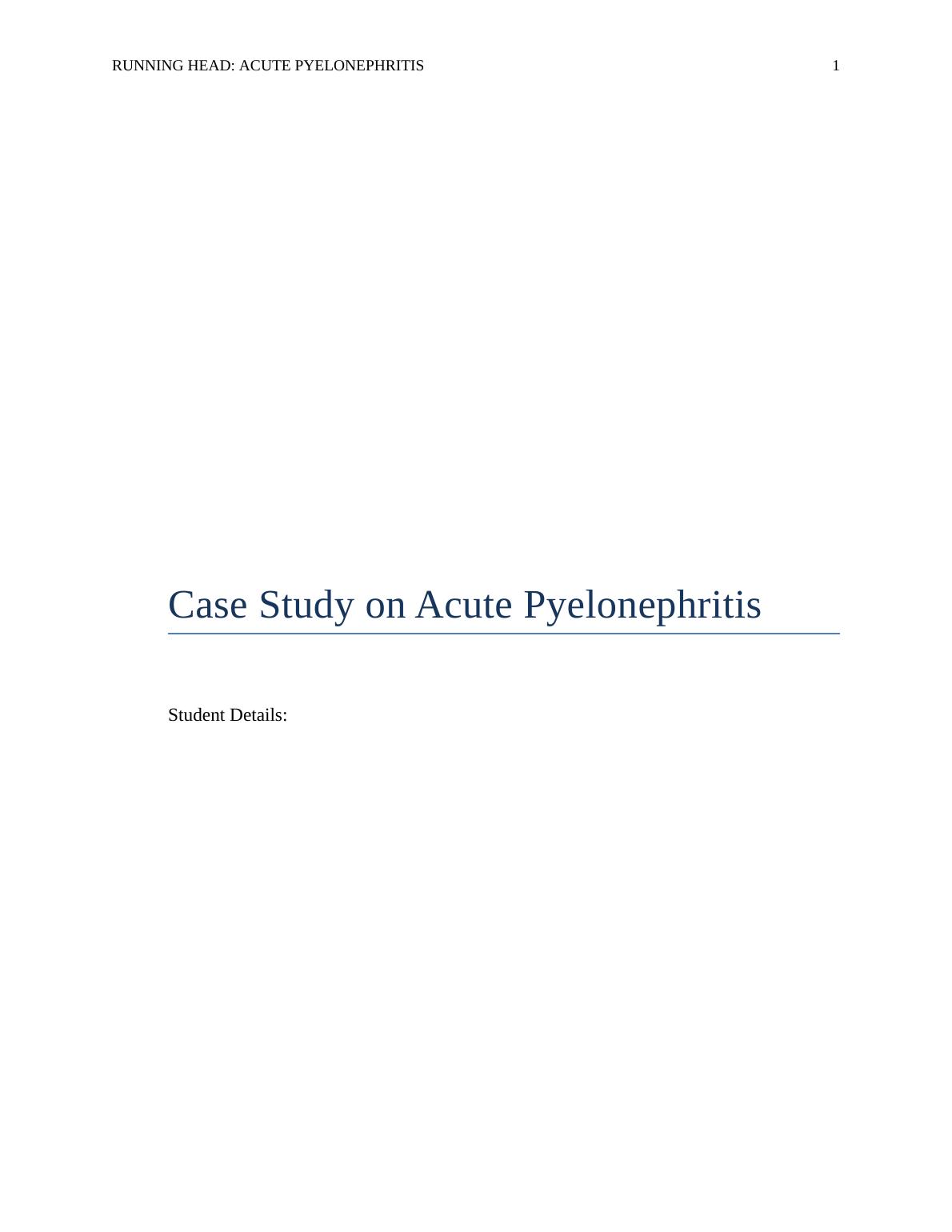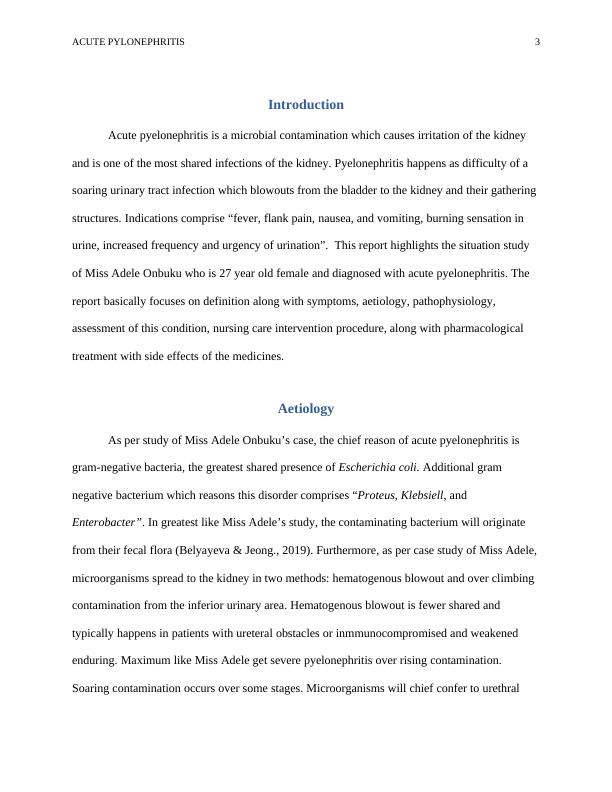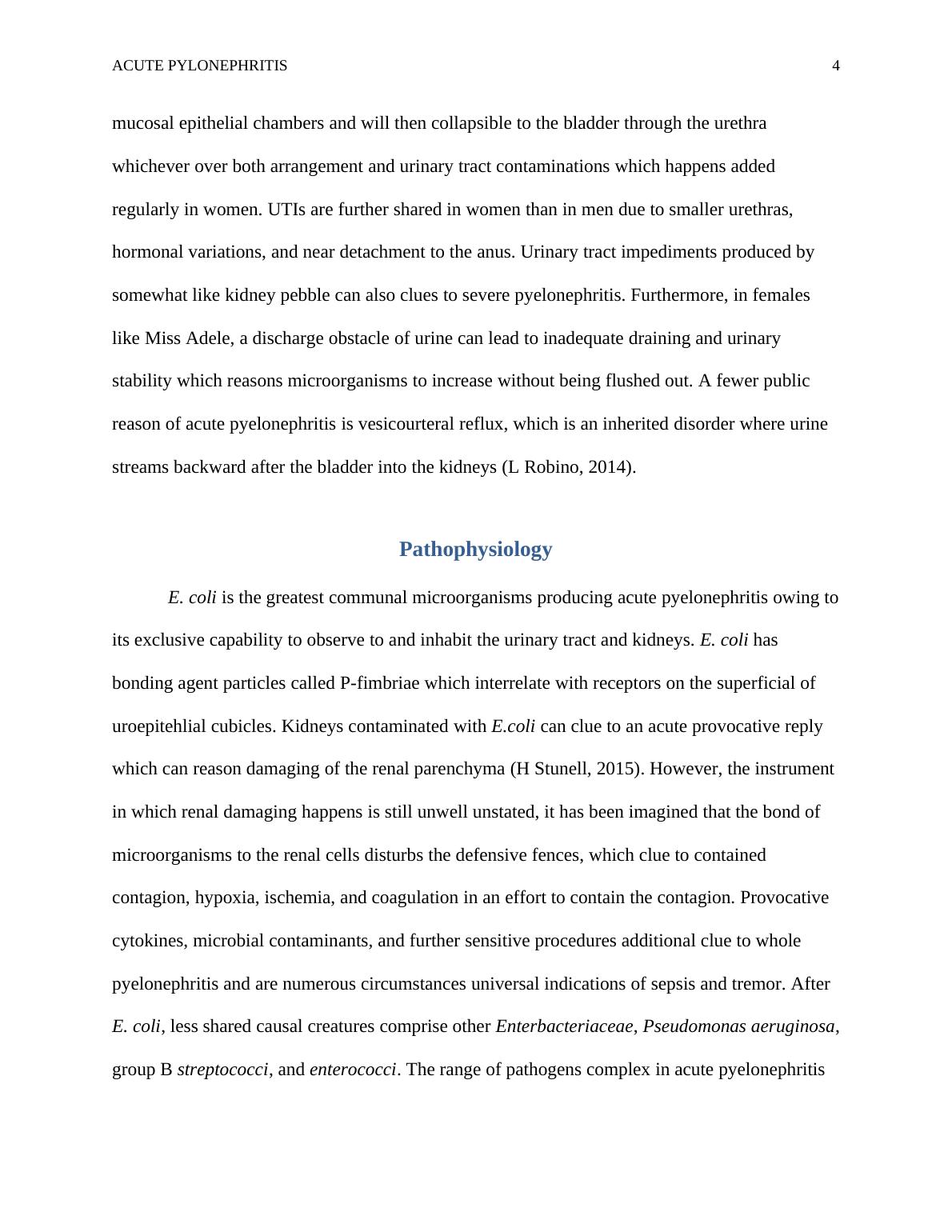Case Study on Acute Pyelonephritis 2022
Added on 2022-10-04
13 Pages2712 Words18 Views
RUNNING HEAD: ACUTE PYELONEPHRITIS 1
Case Study on Acute Pyelonephritis
Student Details:
Case Study on Acute Pyelonephritis
Student Details:

ACUTE PYLONEPHRITIS 2
Contents
Introduction......................................................................................................................................3
Aetiology.........................................................................................................................................3
Pathophysiology..............................................................................................................................3
Evaluation of condition....................................................................................................................4
Nursing care intervention................................................................................................................5
Excess fluid volume.....................................................................................................................5
Activity intolerance.....................................................................................................................5
Ineffective self-health management.............................................................................................5
Anxiety........................................................................................................................................6
Pharmacological treatment with side effects...................................................................................6
Conclusion.......................................................................................................................................8
Bibliography....................................................................................................................................9
Contents
Introduction......................................................................................................................................3
Aetiology.........................................................................................................................................3
Pathophysiology..............................................................................................................................3
Evaluation of condition....................................................................................................................4
Nursing care intervention................................................................................................................5
Excess fluid volume.....................................................................................................................5
Activity intolerance.....................................................................................................................5
Ineffective self-health management.............................................................................................5
Anxiety........................................................................................................................................6
Pharmacological treatment with side effects...................................................................................6
Conclusion.......................................................................................................................................8
Bibliography....................................................................................................................................9

ACUTE PYLONEPHRITIS 3
Introduction
Acute pyelonephritis is a microbial contamination which causes irritation of the kidney
and is one of the most shared infections of the kidney. Pyelonephritis happens as difficulty of a
soaring urinary tract infection which blowouts from the bladder to the kidney and their gathering
structures. Indications comprise “fever, flank pain, nausea, and vomiting, burning sensation in
urine, increased frequency and urgency of urination”. This report highlights the situation study
of Miss Adele Onbuku who is 27 year old female and diagnosed with acute pyelonephritis. The
report basically focuses on definition along with symptoms, aetiology, pathophysiology,
assessment of this condition, nursing care intervention procedure, along with pharmacological
treatment with side effects of the medicines.
Aetiology
As per study of Miss Adele Onbuku’s case, the chief reason of acute pyelonephritis is
gram-negative bacteria, the greatest shared presence of Escherichia coli. Additional gram
negative bacterium which reasons this disorder comprises “Proteus, Klebsiell, and
Enterobacter”. In greatest like Miss Adele’s study, the contaminating bacterium will originate
from their fecal flora (Belyayeva & Jeong., 2019). Furthermore, as per case study of Miss Adele,
microorganisms spread to the kidney in two methods: hematogenous blowout and over climbing
contamination from the inferior urinary area. Hematogenous blowout is fewer shared and
typically happens in patients with ureteral obstacles or inmmunocompromised and weakened
enduring. Maximum like Miss Adele get severe pyelonephritis over rising contamination.
Soaring contamination occurs over some stages. Microorganisms will chief confer to urethral
Introduction
Acute pyelonephritis is a microbial contamination which causes irritation of the kidney
and is one of the most shared infections of the kidney. Pyelonephritis happens as difficulty of a
soaring urinary tract infection which blowouts from the bladder to the kidney and their gathering
structures. Indications comprise “fever, flank pain, nausea, and vomiting, burning sensation in
urine, increased frequency and urgency of urination”. This report highlights the situation study
of Miss Adele Onbuku who is 27 year old female and diagnosed with acute pyelonephritis. The
report basically focuses on definition along with symptoms, aetiology, pathophysiology,
assessment of this condition, nursing care intervention procedure, along with pharmacological
treatment with side effects of the medicines.
Aetiology
As per study of Miss Adele Onbuku’s case, the chief reason of acute pyelonephritis is
gram-negative bacteria, the greatest shared presence of Escherichia coli. Additional gram
negative bacterium which reasons this disorder comprises “Proteus, Klebsiell, and
Enterobacter”. In greatest like Miss Adele’s study, the contaminating bacterium will originate
from their fecal flora (Belyayeva & Jeong., 2019). Furthermore, as per case study of Miss Adele,
microorganisms spread to the kidney in two methods: hematogenous blowout and over climbing
contamination from the inferior urinary area. Hematogenous blowout is fewer shared and
typically happens in patients with ureteral obstacles or inmmunocompromised and weakened
enduring. Maximum like Miss Adele get severe pyelonephritis over rising contamination.
Soaring contamination occurs over some stages. Microorganisms will chief confer to urethral

ACUTE PYLONEPHRITIS 4
mucosal epithelial chambers and will then collapsible to the bladder through the urethra
whichever over both arrangement and urinary tract contaminations which happens added
regularly in women. UTIs are further shared in women than in men due to smaller urethras,
hormonal variations, and near detachment to the anus. Urinary tract impediments produced by
somewhat like kidney pebble can also clues to severe pyelonephritis. Furthermore, in females
like Miss Adele, a discharge obstacle of urine can lead to inadequate draining and urinary
stability which reasons microorganisms to increase without being flushed out. A fewer public
reason of acute pyelonephritis is vesicourteral reflux, which is an inherited disorder where urine
streams backward after the bladder into the kidneys (L Robino, 2014).
Pathophysiology
E. coli is the greatest communal microorganisms producing acute pyelonephritis owing to
its exclusive capability to observe to and inhabit the urinary tract and kidneys. E. coli has
bonding agent particles called P-fimbriae which interrelate with receptors on the superficial of
uroepitehlial cubicles. Kidneys contaminated with E.coli can clue to an acute provocative reply
which can reason damaging of the renal parenchyma (H Stunell, 2015). However, the instrument
in which renal damaging happens is still unwell unstated, it has been imagined that the bond of
microorganisms to the renal cells disturbs the defensive fences, which clue to contained
contagion, hypoxia, ischemia, and coagulation in an effort to contain the contagion. Provocative
cytokines, microbial contaminants, and further sensitive procedures additional clue to whole
pyelonephritis and are numerous circumstances universal indications of sepsis and tremor. After
E. coli, less shared causal creatures comprise other Enterbacteriaceae, Pseudomonas aeruginosa,
group B streptococci, and enterococci. The range of pathogens complex in acute pyelonephritis
mucosal epithelial chambers and will then collapsible to the bladder through the urethra
whichever over both arrangement and urinary tract contaminations which happens added
regularly in women. UTIs are further shared in women than in men due to smaller urethras,
hormonal variations, and near detachment to the anus. Urinary tract impediments produced by
somewhat like kidney pebble can also clues to severe pyelonephritis. Furthermore, in females
like Miss Adele, a discharge obstacle of urine can lead to inadequate draining and urinary
stability which reasons microorganisms to increase without being flushed out. A fewer public
reason of acute pyelonephritis is vesicourteral reflux, which is an inherited disorder where urine
streams backward after the bladder into the kidneys (L Robino, 2014).
Pathophysiology
E. coli is the greatest communal microorganisms producing acute pyelonephritis owing to
its exclusive capability to observe to and inhabit the urinary tract and kidneys. E. coli has
bonding agent particles called P-fimbriae which interrelate with receptors on the superficial of
uroepitehlial cubicles. Kidneys contaminated with E.coli can clue to an acute provocative reply
which can reason damaging of the renal parenchyma (H Stunell, 2015). However, the instrument
in which renal damaging happens is still unwell unstated, it has been imagined that the bond of
microorganisms to the renal cells disturbs the defensive fences, which clue to contained
contagion, hypoxia, ischemia, and coagulation in an effort to contain the contagion. Provocative
cytokines, microbial contaminants, and further sensitive procedures additional clue to whole
pyelonephritis and are numerous circumstances universal indications of sepsis and tremor. After
E. coli, less shared causal creatures comprise other Enterbacteriaceae, Pseudomonas aeruginosa,
group B streptococci, and enterococci. The range of pathogens complex in acute pyelonephritis

End of preview
Want to access all the pages? Upload your documents or become a member.
Related Documents
Case Study on Nursing: Acute Pyelonephritis Diagnosis and Treatmentlg...
|7
|1618
|138
Connection between urinary tract infection (UTI) & acute kidney disease (AKD) : Case Studylg...
|7
|1893
|65
Urinary Tract Infection with Sepsis: Pathophysiology and Nursing Interventionslg...
|7
|1621
|169
